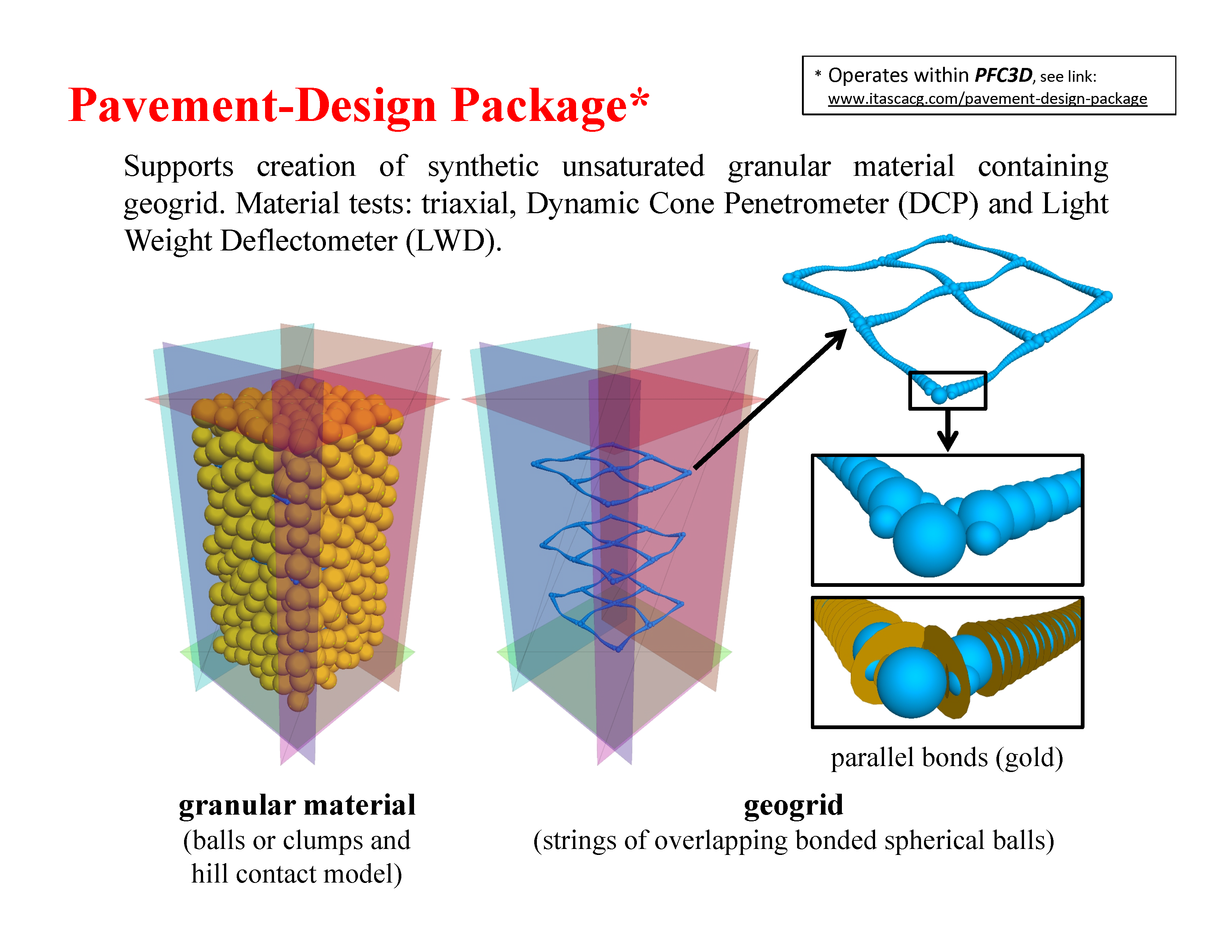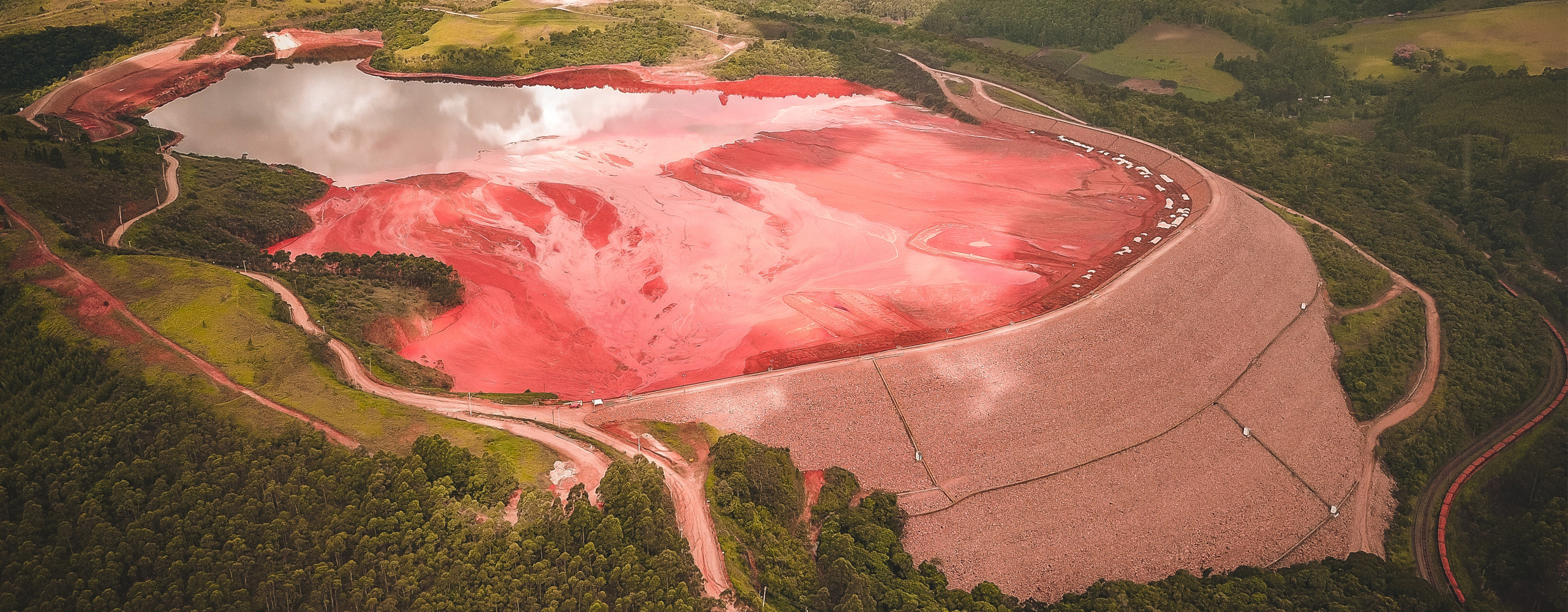The pavement-design package (Potyondy, 2023) for the Particle Flow Code in 3 Dimensions (PFC3D) supports creation and triaxial testing of a synthetic unsaturated granular material containing geogrid.* The geogrid provides lateral restraint to the granular material as a result of interlocking and friction between the geogrid and the granular material, and this is believed to be the primary structural benefit of adding geogrid to the aggregate base layer of a pavement structure. The package can be used to study and quantify the effect of microstructural properties on macroscopic response, which includes the stress-strain curves produced during triaxial tests. The microstructural properties of the granular material include: grain size distribution of spherical or clumped grains, grain material type, moisture content and initial specimen porosity. The microstructural properties of the geogrid include: geometry, structural stiffness and grid-grain interface behavior. The package is being used to improve pavement-design methodology in Minnesota by estimating geogrid gain factors (defined as the ratio of resilient modulus of the aggregate base with geogrid to resilient modulus of the aggregate base without geogrid) for typical geogrid-reinforced aggregate roadway configurations in which the grain-size distribution, initial specimen porosity, moisture content and confining stress are varied (Potyondy et al., 2016; Siekmeier et al., 2016; Siekmeier and Casanova, 2016). The package could be extended to investigate the behavior of other aggregate-geogrid systems such as a geogrid pull-out or wheel-load test.

* [The pavement-design package is provided in the form of a consistent set of FISH functions that operate within PFC3D versions 7.0 and 6.0. FISH is a programming language embedded within PFC3D. The PFC3D code can be obtained from {www.itascacg.com/software/pfc}, and the pavement-design package is provided below. For the PFC3D 5.0 pavement design package, visit www.itascacg.com/pavement-design-package-pfc3d-5.
REFERENCES
Potyondy, D. (2023) "Pavement-Design Package for PFC3D [pdPkg7.1]," Itasca Consulting Group, Inc., Technical Memorandum ICG16-8528-15TM (July 6, 2023), Minneapolis, Minnesota. DOWNLOAD LINK
Potyondy, D. (2019) "Pavement-Design Package for PFC3D [pdPkg6.1]," Itasca Consulting Group, Inc., Technical Memorandum ICG16-8528-15TM (April 17, 2019), Minneapolis, Minnesota. DOWNLOAD LINK
The additional references cited above are defined in the references section of the pavement-design package memo, and the documents themselves are provided in the pdPkgN/Documentation directory.
FILES:
Version 7:
pdPkg7.1 (ZIP, 271 MB)
PavementDesignPkg[pdPkg7.1].pdf (24 MB)
Version 6:
pdPkg6.1 (ZIP, 216 MB)
PavementDesignPkg[pdPkg6.1].pdf (24 MB)
Pavement-Design Package Software Update Revisions
| pdPkg Release | fistPkg Release | PFC3D RELEASE | Date / Description |
|---|---|---|---|
| 7.1 | 7.3 | 7.00.159 | 07/06/23 Release of pdPkg for PFC3D 7.0. pdPkg7.1 provides the same capabilities as pdPkg6.1. Added Documentation\ElseyEtal(2023)-geogridDesignSpec.pdf. |
| 6.1 | 6.5 | 6.00.12 | 04/17/19 Release of pdPkg for PFC3D 6.0. The package for PFC3D 5.0 uses the naming convention pdPkgM, where M is the package version number. The package for PFC3D 6.0 uses the naming convention pdPkg6.N, where N is the package version number. The syntax of commands and FISH items has been modified to be compatible with PFC3D 6.0. The package is ready for use. pdPkg6.1provides the same capabilities as pdPkg15, with the following exception. The example project MatGen-HillGrid_C5Q is not included. This is the realistic example in the pdPkg memo. A better realistic example is provided by the example project MatGen-HillGrid_5Q of a typical roadway model (see ModelValidationTests.pdf). |
| 15 | 26 | 5.00.39 | 04/08/19 Complete final pdPkg for PFC3D version 5. This package will be ported to operate with PFC3D version 6. Add magazine article (Siekmeier&Bittmann(2019)-MN_UseOfGrid.pdf) to Documentation directory. This article describes the work that has been recognized by the University of Minnesota Center for Transportation Studies 2018 Research Partnership Award to Geogrid Reinforced Aggregate Base Pavement Design. Add report (Siekmeier(2018)-GeogridAggBase.pdf) to Documentation directory. This report utilizes the pavement-design package to provide a performance specification consisting of DCP and LWD target values for geogrid reinforced aggregate base. |
| 14 | 25 | 5.00.35 | 6/22/2018 Provide report (PFC_PavementDesign-Phase2.pdf) and associated documents in Documentation directory. This report summarizes the work for the MnDOT project "Geogrid Specification for Aggregate Base Reinforcement." The pdPkg14 is the deliverable of the project. |
| 13 | 25 | 5.00.32 | 3/10/2018 The package has been provided to John Siekmeier of MnDOT as a deliverable for the project "Geogrid Specification for Aggregate Base Reinforcement." The work is summarized as follows, with documentation listed in square brackets after each item --- see REFERENCES section below for abbreviations.
REFERENCE Mahmud, S.M.N. (2017) "Effect of Particle Size Distribution and Packing Characteristics on Railroad Ballast Shear Strength: A Numerical Study Using the Discrete Element Method," M.S. Thesis, Boise State University [advisor: Deb Mishra]. REFERENCES (in Documentation directory) [fistPkg] Potyondy, D. (2017) “Material-Modeling Support in PFC [fistPkg25],” Itasca Consulting Group, Inc., Technical Memorandum ICG7766-L (March 16, 2017), Minneapolis, MN. [pdPkg] Potyondy, D. (2018) “Pavement-Design Package for PFC3D [pdPkg13],” Itasca Consulting Group, Inc., Technical Memorandum ICG16-8528-15TM (March 9, 2018), Minneapolis, MN. [BCM] Potyondy, D. (2018) “Beam Contact Model [version 1],” Itasca Consulting Group, Inc., Technical Memorandum 2-3558-01:17TM07 (March 9, 2018), Minneapolis, MN. [MV] Potyondy, D. (2018a) "Model-Validation Tests," Itasca Consulting Group, Inc., Technical Memorandum 2-3558-01:17TM52 (March 9, 2018), Minneapolis, MN. MODIFICATIONS
|
| 12 | 25 | 5.00.30 | 4/10/2017 MODIFICATIONS
REFERENCES Potyondy, D. (2017b) "Pavement-Design Package for PFC3D [pdPkg12]," Itasca Consulting Group, Inc., Minneapolis, MN, Technical Memorandum ICG16-8528-15TM (April 6, 2017). |
| 11 | 24 | 5.00.27 | 10/17/2016 MODIFICATIONS
|
| 10 | 23 | 5.00.24 | 06/23/2016 MODIFICATIONS
|
The first column of this table lists the Pavement-Design Package revision number; the second and third columns list the PFC 6.0/7.0 FISHTank and PFC3D 6.0/7.0 release, respectively, against which the Pavement-Design Package has been tested; and the fourth column describes the Pavement-Design Package revision. Note that each revision of the Pavement-Design Package is expected to operate with a PFC 6.0/7.0 FISHTank and PFC3D 6.0/7.0 release that is current or newer than that listed. Since newer revisions of the Pavement-Design Package may use features available only in newer revisions of the supporting software, they may not be compatible with older revisions of the supporting software.
